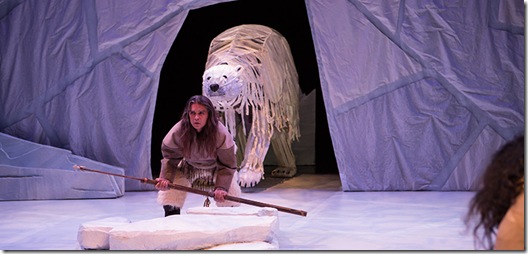Stratford’s Breathing Hole is one for the memory books.
Photo: Cylla Von Tiedemann
STRATFORD, Ontario — Our first encounter with the mythic polar bear dominating the Stratford Festival’s stunning production of The Breathing Hole comes at the very beginning when a widowed Inuit woman takes an orphaned one-eared cub into her care.
Our last sighting of of Angu’juaq — for that is the name bestowed on this creature — comes 500 years later, and the moment is heartbreaking.
By the end of the evening, we’re aware that Colleen Murphy’s remarkable play is making an ecological statement. But unlike The Madwoman Of Chaillot, another late-season Stratford offering with the environment on its mind, it radiates genuine heart when it comes to environmental matters. The self-congratulatory aren’t-we-being-clever flavour of Jean Giradoux’s satirical fantasy has no place in the sensibility of The Breathing Hole. It is an intensely human play tinged at the end with a melancholy that is palpable.
We’re conscious that we are witnessing a work of epic proportions. It’s also an epic that — astonishingly — is happening in the intimacy of the Studio Theatre, the festival’s smallest performing space.
This space was the brainchild of the late Richard Monette, Stratford’s longtime artistic director, and it may well be his most valued legacy. Monette used to argue that the the Studio and its stage had an undreamed-of potential and that all that it needed was a director of vision to unleash it.
That’s what’s happening with The Breathing Hole, which begins with a glimpse into Inuit culture as it existed in 1534, around the same time that Jacques Cartier was crossing the Atlantic. It then ushers us into the early 19th Century and the disastrous Arctic adventure of explorer Sir John Franklin, and eventually ends with 21st Century oil crews seeking liquid gold while the shadow of ecological disaster grows larger.
This makes for compelling theatre. Indeed the presence of the grown Angu’juaq alone is sufficient to single out the play as something special as he periodically lumbers into view, fishes for seals through the breathing hole in the Arctic ice and proves to be a loyal friend to the Inuit community that saved him as a cub from a floe.
We’ve first seen him as a beguiling hand puppet, cunningly manipulated by actress Jani Lauzon, excellent as the little bear’s Inuit protector. But then he becomes a palpable adult presence, a striking example of large-scale animal puppetry whose movements suspend our disbelief in the same way that Joey the horse did in the National Theatre of Britain’s celebrated production of The War Horse.
Designer Daniella Masellis, whose spare but eloquent settings evoke the grandeur and mystery of the Arctic, is responsible for the evolving look of Angu’juaq. But it is the supple presence of actor Bruce Hunter within that lumbering frame that gives this creature life and personality — and the result is memorable.
But this lovable polar bear is only one component in a production that is truly historic in reflecting Stratford’s growing commitment to indigenous theatre. Several Inuit actors are part of the festival company this season, and they bring dramatic truth to the opening scenes. The production boasts an indigenous director in Reneltta Arluk, who brings an emotional and epic sweep, as well as a quiet
wisdom, to her assignment.
Arluk’s affinity for dramatic contrast is particularly evident in the two scenes involving explorer Sir John Franklin. First those moments when the newly arrived Franklin and his officers, as spic and span as if they’ve just emerged from an English country house, enjoy afternoon tea on the Arctic ice, confident that their quest for the Northwest Passage will be successful. The satire here is gentle but still cutting. But then we see them, dirty and bedraggled and maddened, their vessel permanently trapped in the ice, as they await their doom.
There is, of a course, a different kind of doom hovering at the end, and Arluk’s production is seamless in its modulations and in evoking the passage of time. She also understands the power of simplicity. At the beginning simple child-like silhouettes of living creatures breaking the whiteness of a glacial backdrop; at the end, the forbidding silhouette of oil derricks.
Play and production have a lot of things on their mind — culture shock, the lessons of history, the collision between the spirit and secular worlds, and of course the very future of the North. And it’s a compelling ensemble cast that brings utterance to these concerns. Among the performances that linger in the mind: Johnny Issaluk, excellent as an Inuit hunter who has good reason to be suspicious of bears; Randy Hughson disintegrating before our very eyes as Sir John Franklin; Miali Buscemi cutting a pair of striking contrasts in showing us the Inuit world then and now; Ujarneq Fleischer and Jimmy Blais in a pair of robust performances as two young hunters.
Stratford can be justly proud of The Breathing Hole. It’s a winner.
(The Breathing Hole continues to Sept. 22. Ticket information at 1 800 567 1600 or stratfordfestival.ca)
